When it comes to Vietnamese cuisine, the variety of fresh herbs, vibrant dishes, and aromatic broths often take center stage. Yet, there’s one element that quietly elevates each bite into a harmonious blend of flavors: the Vietnamese dipping sauce. This essential component enhances the taste of countless dishes, from grilled meats to fresh spring rolls, making every meal a flavorful experience. Whether balancing the richness of a dish or adding a burst of umami, Vietnamese dipping sauce plays a vital role in the country’s culinary culture.
Vietnamese Dipping Sauce: The Soul of Vietnamese Cuisine

In Vietnamese cuisine, the beauty lies in its simplicity, yet the flavors are layered and complex. Many dishes, such as Pho Cuon, Nem Cuon (fresh spring rolls), and Bun Dau Mam Tom (tofu and fermented shrimp paste), are often composed of fresh, unseasoned ingredients that rely heavily on the dipping sauce for their final burst of flavor. This makes it no exaggeration to say that Vietnamese dipping sauce is the soul of these culinary delights. Each sauce is crafted to complement a specific dish, elevating the entire dining experience with its distinct taste.
For instance, the pungent and robust Mam Tom (fermented shrimp paste) pairs perfectly with Bun Dau, bringing out a depth of flavor that no other Vietnamese dipping sauce—Nuoc Mam (fish sauce) included—can replicate. The delicate balance of saltiness, sweetness, and sometimes spiciness in these sauces adds the necessary complexity to relatively simple dishes, making every bite memorable.
Vietnamese Dipping Sauce: Born from the Need for Preservation
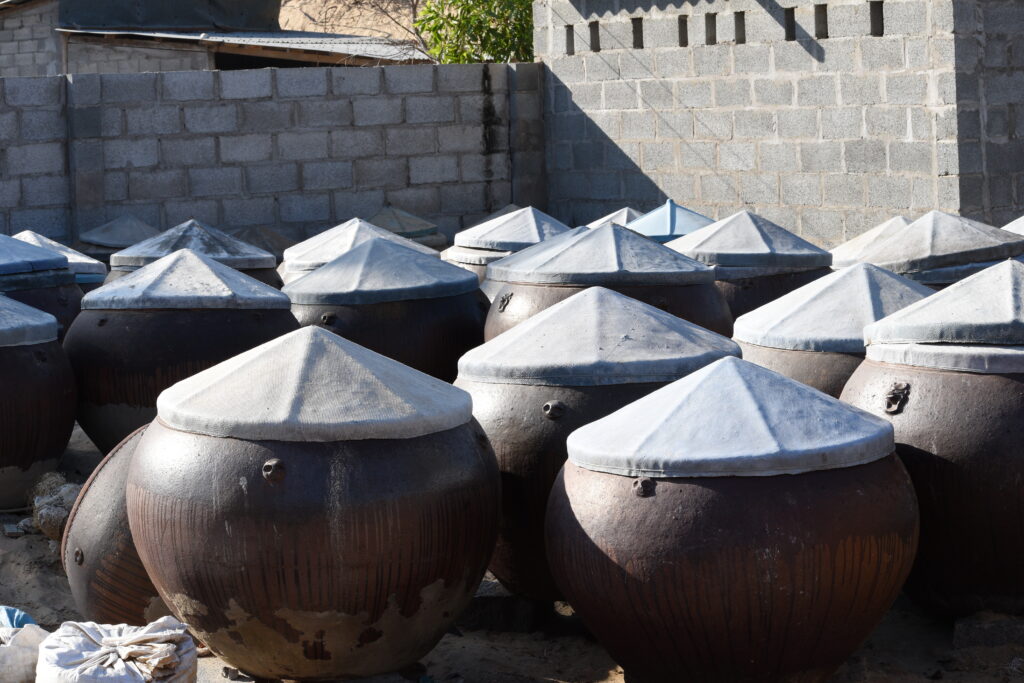
Vietnam’s geography, with its long vertical stretch and over 3,260 kilometers of coastline, provides an abundant source of seafood. The country’s dense network of rivers, lakes, and ponds also contributes to the availability of freshwater fish. When fishermen found themselves with more fish than they could consume immediately, they turned to preservation methods, primarily fermenting the fish with salt to create flavorful sauces that could be stored and used over time.
This practice led to the development of numerous types of Vietnamese dipping sauce, each with a unique flavor profile. From Nuoc Mam to Mam Tom and other regional specialties, these sauces became integral to Vietnamese meals. Fermentation not only preserved the fish but also intensified the umami flavors that make these sauces indispensable in Vietnamese households.
In Vietnam, dipping sauce is as varied as the dishes themselves. While Nuoc Mam (Fish Sauce) is the most renowned, the world of Vietnamese dipping sauce is rich with other flavors that complement traditional meals. Jackfruit Adventure is excited to introduce the top 9 most popular Vietnamese dipping sauces that are staples in every household, bringing depth and authenticity to Vietnamese cuisine.
Popular Types of Vietnamese Dipping Sauce
Vietnamese cuisine is famous for its rich variety of dipping sauces, each contributing its own unique flavor to elevate the dishes they accompany. Let’s take a closer look at some of the most popular types of Vietnamese dipping sauce that have become integral to Vietnamese meals.
Nuoc Mam (Fish Sauce)

Nuoc Mam, or fish sauce, is without a doubt the most iconic and widely used Vietnamese dipping sauce. It’s a staple in every Vietnamese household, where it serves as both a cooking ingredient and a dipping sauce. Fish sauce has been an integral part of Vietnamese cuisine for more than 1,000 years, with its origins deeply rooted in the country’s history and culinary traditions. Despite no definitive answer as to when exactly fish sauce became popular, it’s clear that it has remained a beloved element of Vietnamese dining for centuries.
Fish sauce is prepared using a traditional fermentation method. Fresh fish, often anchovies, are mixed with salt in a ratio of about 3:1. This mixture is then placed into large wooden barrels, compressed, and left to ferment for several months, allowing the fish and salt to transform into a liquid gold that we call Nuoc Mam. The first extraction, known as “nuoc cot,” is the purest and most prized, boasting a rich amber color and a delicate balance of umami flavors. The fish sauce’s aroma changes from fishy to savory, while its protein content is highest during this first pressing. After this, the remaining fish residue is further fermented to create subsequent, lower-quality batches.
Phu Quoc Fish Sauce and Phan Thiet Fish Sauce are renowned for their superior quality and rich flavor. These regions are known for producing high-quality, artisanal fish sauces using traditional methods passed down through generations. On the other hand, commercial brands like Nam Ngu and Chin Su are household names and widely available across Vietnam, making them popular choices for day-to-day use.
How to Make Vietnamese Fish Sauce Dipping Sauce (Nuoc Mam Cham)
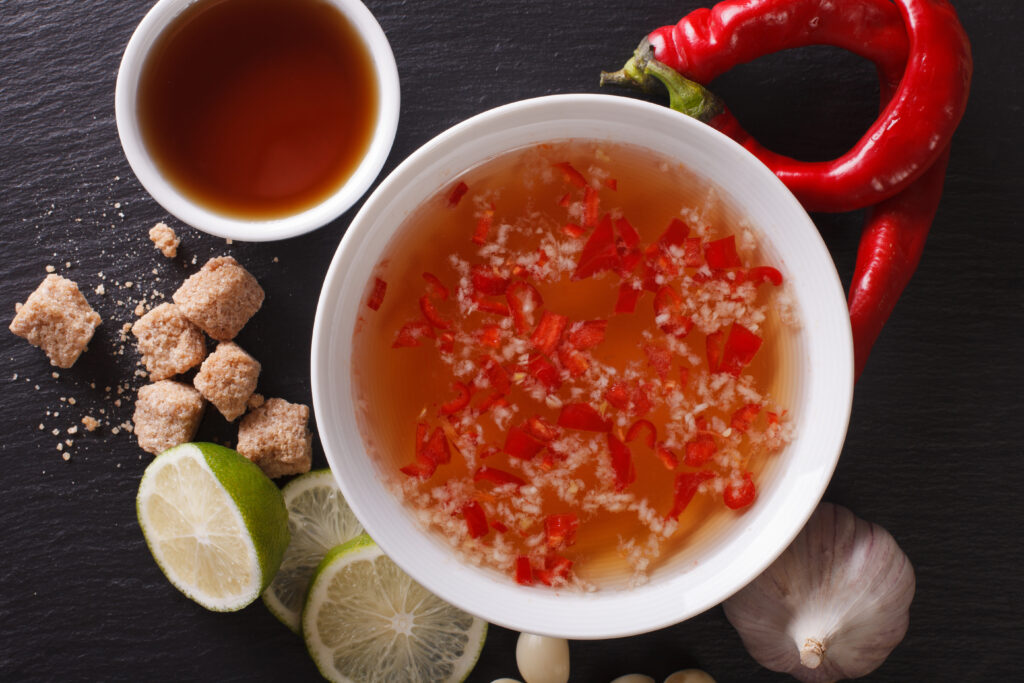
While pure fish sauce is often used for cooking, Nuoc Mam Cham is the most common way to serve fish sauce as a dipping sauce. It’s usually prepared by diluting fish sauce with water and adding sugar, lime juice, garlic, and chili. The result is a balanced sweet, sour, salty, and spicy dipping sauce that enhances the flavors of many Vietnamese dishes. Here’s a simple recipe for making your own fish sauce dipping sauce:
Ingredients
- 2 tablespoons of fish sauce
- 2 tablespoons of lime juice (or vinegar)
- 1–2 tablespoons of sugar (adjust to taste)
- 4 tablespoons of warm water
- 1–2 cloves of garlic (minced)
- 1–2 small red chilies (chopped)
Instructions
- Dissolve the sugar in warm water first to ensure smooth blending.
- Add fish sauce and lime juice (or vinegar) to the sugar-water mixture.
- Stir in minced garlic and chopped chilies for added flavor.
- Taste the sauce and adjust the balance of sweetness, saltiness, and acidity to your liking.
This dipping sauce can be adjusted according to personal taste preferences by adding more sugar for sweetness or more lime for tanginess.
What to Eat with Fish Sauce (Nuoc Mam Cham)
Fish sauce dipping sauce is extremely versatile and pairs well with a wide variety of Vietnamese dishes. Here are some classic combinations:
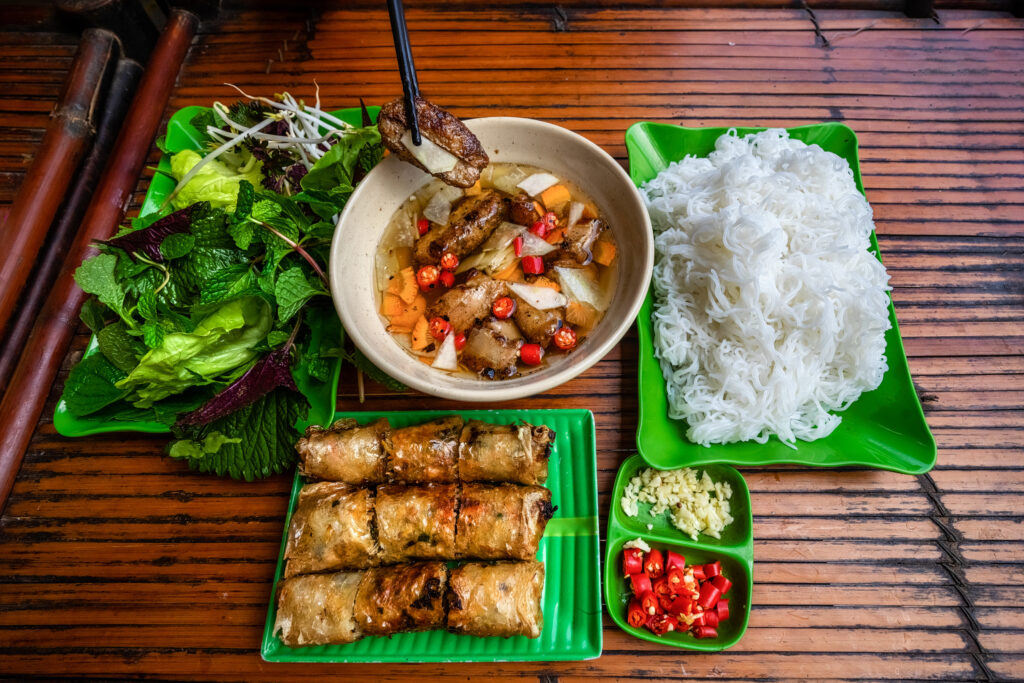
- Spring Rolls (Nem Cuon or Cha Gio): Fresh or fried spring rolls are commonly served with fish sauce, creating the perfect balance of fresh herbs, crunchy vegetables, and the tangy kick of the sauce.
- Grilled Pork Vermicelli (Bun Thit Nuong): This popular Vietnamese dish features grilled pork, rice noodles, and fresh herbs, all of which are brought together by a drizzle of fish sauce dipping sauce.
- Vietnamese Pancakes (Banh Xeo): These crispy, savory pancakes are filled with shrimp, pork, and bean sprouts, and fish sauce is a must-have for dipping.
- Vietnamese Steamed Rice Rolls (Banh Cuon): Delicate rolls of rice flour filled with minced pork and mushrooms are often served with fish sauce as a dipping sauce.
- Boiled Vegetables and Meat: A simple yet traditional way of eating is by dipping boiled vegetables, tofu, or meat into fish sauce to bring out the umami flavors.
Fish sauce is an indispensable element in Vietnamese cuisine. Whether you’re cooking with it or using it as a dipping sauce, it’s the secret behind the delicious flavors in many Vietnamese dishes.
Mam Tom (Fermented Shrimp Paste)
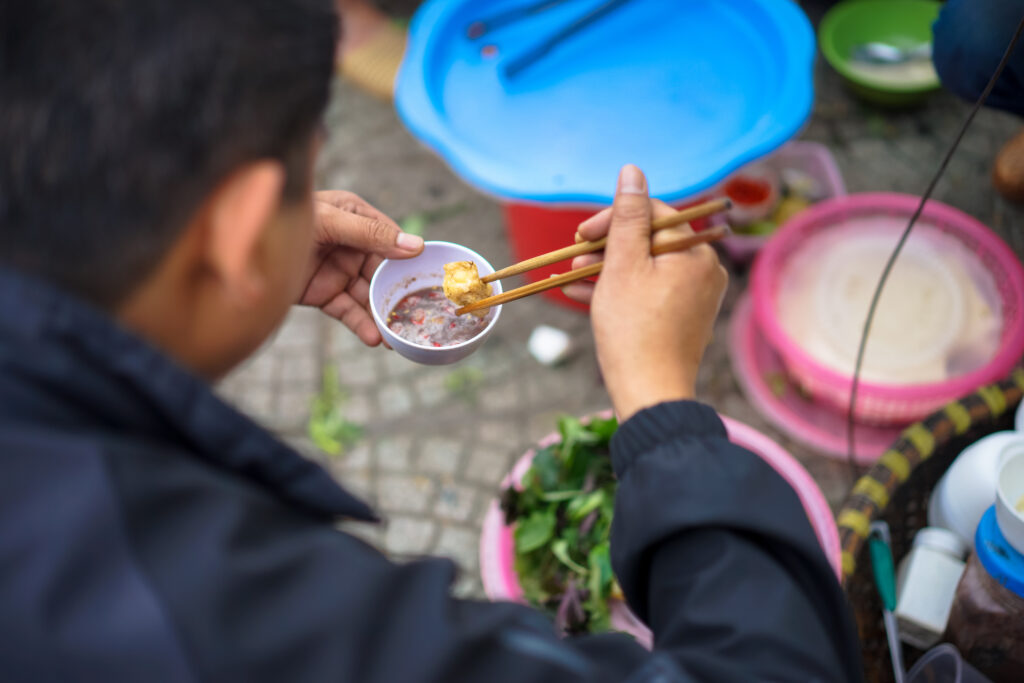
Mam Tom, or fermented shrimp paste, is a quintessential Vietnamese dipping sauce, ranking just behind Nuoc Mam (fish sauce) in popularity. Known for its thick consistency, bold aroma, and deep umami flavor, Mam Tom is a sauce that divides opinions—while some may find it overpowering, others consider it an irreplaceable part of traditional Vietnamese cuisine. This sauce, made from fermented shrimp or tiny fish, combined with salt, undergoes a lengthy fermentation process that results in its distinctive taste and light purple hue.
Mam Tom is not only used as a dipping sauce but also as a seasoning and base for many traditional Vietnamese dishes. It acts as a flavor booster, adding depth and umami to stews, broths, and marinades. For those who have grown up with it, Mam Tom holds nostalgic value, representing the flavors of home and family gatherings. Although its intense aroma might be intimidating to those unfamiliar with it, once tasted, it reveals a complex, savory profile that keeps people coming back for more.
Fermented shrimp paste truly showcases the diversity and richness of Vietnamese dipping sauce and adds a uniquely authentic experience to any Vietnamese meal. Whether used as a standalone dip or incorporated into recipes, Mam Tom is a cultural and culinary gem that continues to play a significant role in Vietnamese cuisine.
How to Make Fermented Shrimp Paste Dipping Sauce
Preparing the shrimp paste dipping sauce involves balancing its intense flavor with sweetness and acidity. Below is a simple recipe you can try at home to create a versatile dipping sauce.
Ingredients
- 2 tablespoons fermented shrimp paste (Mam Tom)
- 2 tablespoons granulated sugar
- 2 tablespoons fresh lime or lemon juice (about 1 small lemon or lime)
- 1 tablespoon water (adjust to reach desired consistency)
- 1 teaspoon MSG (optional but recommended for extra umami)
- 4 cloves garlic (peeled and minced)
- Chili peppers (sliced thin, optional for heat)
Instructions
- In a small mixing bowl, combine the shrimp paste, sugar, lime juice, and MSG. Stir thoroughly until all the ingredients dissolve, and the mixture reaches a smooth consistency.
- Add the minced garlic into the sauce and mix well.
- Finally, garnish with sliced chili peppers to taste, for an added kick of spice.
The dipping sauce can be adjusted to individual preferences—some may prefer it sweeter by adding more sugar, while others may enjoy it more diluted with water or tangier with an extra squeeze of lime.
What to Eat with Mam Tom (Fermented Shrimp Paste)
Mam Tom is a versatile dipping sauce that accompanies a variety of beloved Vietnamese dishes. Its strong, savory flavor pairs well with both simple and complex meals, making it indispensable in traditional Vietnamese dining.
- Bun Dau Mam Tom (Vermicelli with Fried Tofu and Shrimp Paste): Perhaps the most well-known dish paired with Mam Tom, this is a street food favorite across Northern Vietnam. The dish consists of fried tofu cubes, vermicelli noodles, and an assortment of fresh herbs, all served with a side of fermented shrimp paste for dipping. The sauce is often whipped with lemon or lime juice to create a frothy texture and mellows the intense flavor. A touch of sugar can be added to balance the salty and sour notes, making it easier for newcomers to enjoy.
- Boiled Pork Intestines: Mam Tom is also a go-to dipping sauce for boiled pork intestines, a delicacy in Vietnam. Paired with herbs like mint, galangal, and sour fruits such as starfruit or banana, the dipping sauce enhances the flavor of the meat and adds complexity to the dish.
- Eggplant with Shrimp Paste: A rustic dish found in the northern countryside, where Mam Tom serves as a side sauce for pickled eggplant, adding a burst of flavor to the simple yet delicious meal. The shrimp paste’s salty intensity cuts through the eggplant’s soft texture, making it a popular choice for home-cooked meals.
- La Vong Fish Cakes (Cha Ca La Vong): In Hanoi, Mam Tom is used to accompany the famous Cha Ca La Vong, a dish of turmeric-marinated grilled fish with dill. A dollop of this fermented shrimp paste elevates the fish’s flavor and adds an extra layer of richness. For an added touch, some diners like to mix in hot fried fat to make the sauce even more indulgent.
- Northern Hotpot (Lau Mam): In the northern regions, Mam Tom is an essential ingredient in various hotpot broths, such as Lau Mam (Fermented Hotpot). Its robust flavor adds depth to the broth, creating a savory and rich base that perfectly complements the fresh seafood and vegetables used in the dish.
- Bun Rieu (Crab Vermicelli Soup): In this iconic crab-based noodle soup, Mam Tom adds a salty and savory undertone that enhances the sweetness of the crab. The subtle incorporation of shrimp paste in the broth balances the other ingredients and intensifies the overall flavor.
- Bun Thang (Hanoi Combo Noodle Soup): A complex noodle dish that requires careful attention to flavor balance, Bun Thang uses shrimp paste to bring out the richness in the soup, blending seamlessly with the chicken, eggs, and other ingredients.
Mam Nem (Fermented Anchovy Sauce)

Mam Nem, also referred to as Mam Cai, is a cherished Vietnamese dipping sauce that holds a special place in the culinary traditions of the central coastal provinces of Vietnam. This sauce is made from fermented fish, typically anchovies, scads, herring, cobia, or paraplegic fish, which are salted and left to ferment. The process of making Mam Nem can vary slightly—sometimes the fish are deboned, other times they are left whole. Over time, the mixture is combined with various ingredients, such as pineapple and sugar, to balance its robust flavor. There are two main types of Mam Nem: whole fish sauce and pureed fish sauce. The pureed version is stirred during the fermentation process to quicken the process.
People in the Central region have historically made Mam Nem as a way to preserve food for rough seas or stormy days when fishing is impossible, and fresh food becomes scarce. Its savory, slightly sweet, and pungent taste makes it the backbone of many traditional dishes in this part of Vietnam.
The process of making Mam Nem may seem simple, but it requires experience and precision. Achieving the perfect balance between fish and salt is crucial to creating a sauce that is flavorful without being overly salty. Traditionally, Mam Nem is left to ferment for around three months, although this can vary depending on the weather and environmental conditions. The end result is a sauce that bursts with flavor and has a distinct aroma—a true reflection of Vietnam’s rich culinary heritage.
In every Central Vietnamese household, Mam Nem remains a staple that adds depth and authenticity to local dishes. Its presence on the dining table is more than just a dipping sauce—it’s a connection to the region’s history, traditions, and resourceful approach to food preservation.
How to Make Mam Nem (Fermented Anchovy Sauce)
Here’s a simple recipe to prepare this bold-flavored sauce at home:
Ingredients
- 1 tablespoon vegetable oil
- 1 tablespoon minced lemongrass
- 2 cloves garlic (finely minced)
- 1/4 cup bottled fermented fish sauce (Quê Hương Mắm Nêm is a good option)
- 1/2 cup crushed pineapples
- 1/2 tablespoon sugar (adjust to taste)
- 1 tablespoon lemon or lime juice
- Red chili peppers (finely minced, adjust based on your heat tolerance)
Instructions
- Heat up the vegetable oil in a small pan over medium-high heat.
- Add minced garlic and lemongrass, and sauté until they become fragrant, which takes about 15 seconds.
- Stir in the fermented fish sauce, crushed pineapples, sugar, lemon or lime juice, and minced chili peppers. Adjust the amount of sugar based on the sweetness of the pineapples. Stir well to combine the ingredients.
- Once the mixture reaches a boil, turn off the heat. Your Mam Nem is now ready to serve.
What to Eat with Mam Nem (Fermented Anchovy Sauce)
Mam Nem is a versatile dipping sauce that enhances many rustic and everyday dishes. Depending on the region and the meal, the sauce can be prepared in different ways, such as using it whole, pureed, or in combination with other ingredients. In central Vietnam, Mam Nem is considered the soul of several beloved dishes. Its rich, pungent, and savory flavors pair perfectly with foods that have subtle or mild tastes, making it an irreplaceable companion for many meals.
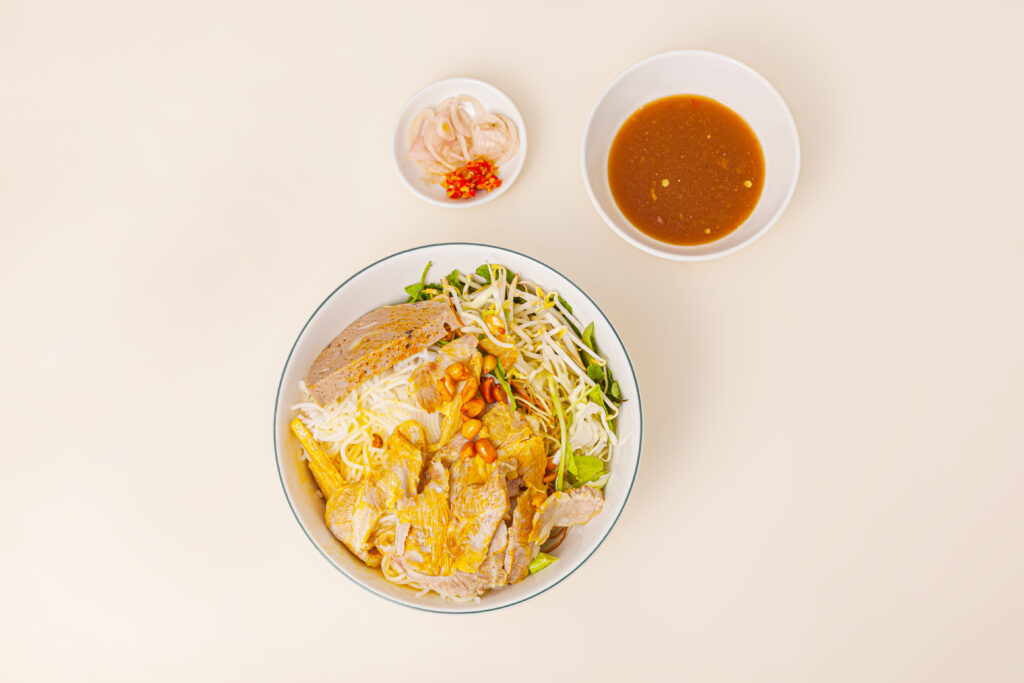
- Grilled Pork Rice Paper Rolls (Banh Trang Cuon Thit Heo): Thin slices of grilled pork are rolled with fresh herbs and vegetables inside rice paper, then dipped into Mam Nem, which elevates the flavor of the fresh ingredients.
- Vermicelli with Fermented Anchovy Sauce (Bun Mam Nem): This rustic dish is commonly enjoyed in the Central region, where noodles are served with fresh herbs, vegetables, and Mam Nem. The sauce’s intensity enhances the light and fresh ingredients, creating a harmonious blend of textures and flavors.
- Grilled Meat Vermicelli (Bun Thit Nuong): One of the most popular uses of Mam Nem is as a dipping sauce for grilled pork or beef vermicelli. The combination of sweet, smoky meat with the strong, salty punch of the sauce is irresistible.
Mam Ruoc (Fermented Tiny Shrimp Sauce)
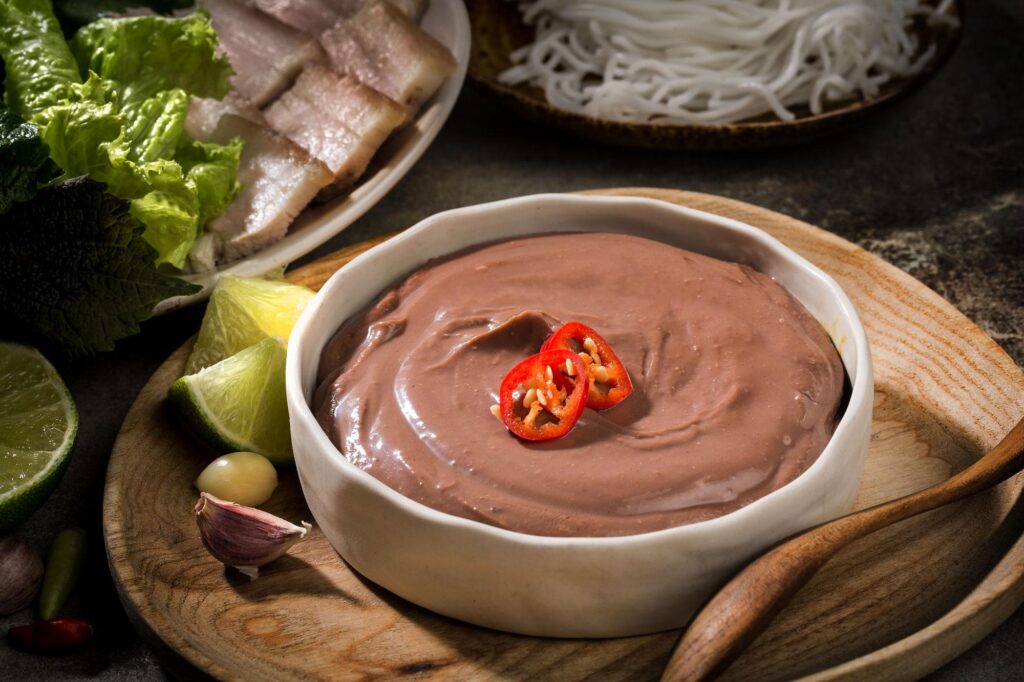
Mam Ruoc is a distinctive Vietnamese dipping sauce made from tiny shrimp, often referred to as “sea shrimp” or moi, found in brackish or saltwater environments. Unlike its stronger counterpart Mam Tom (fermented shrimp paste), Mam Ruoc has a milder taste and aroma. Its less pungent flavor and more fragrant profile make it a staple in Vietnamese cuisine and an essential ingredient in Southeast Asian cooking, particularly in Vietnam and southern China.
How Mam Ruoc is Made
The production of Mam Ruoc involves fermenting tiny shrimp with salt over a period of 6 to 10 months. The lengthy fermentation allows the shrimp to decompose fully, resulting in a thick, flavorful paste rich in umami. Achieving the right balance in texture and flavor is labor-intensive, and the precise ratio of shrimp to salt is crucial to the final product’s quality.
Although the process takes longer than making Mam Tom, this extended fermentation is believed to offer health benefits. Studies show that long fermentation helps break down proteins and amino acids, improving digestion and enhancing the sauce’s nutritional value.
How to Use Mam Ruoc
Mam Ruoc is widely versatile and can be used in several ways:
- As a Cooking Ingredient: It is commonly used in soups and stews like bun bo Hue (spicy beef noodle soup) or canh chua (Vietnamese sour soup). The sauce adds a rich, umami-packed layer of flavor to these dishes.
- As a Dipping Sauce: Although less commonly used as a dipping sauce than other Vietnamese condiments, Mam Ruoc can be mixed with water, sugar, and lime juice to make a milder dipping sauce for fresh vegetables or grilled meats.
- With White Rice: Many Vietnamese enjoy a simple meal of Mam Ruoc with steamed white rice. Its savory taste turns a basic meal into a satisfying dish.
Signature Dish: Vietnamese Caramelized Pork Belly with Fermented Shrimp Paste (Thit Xao Mam Ruoc)
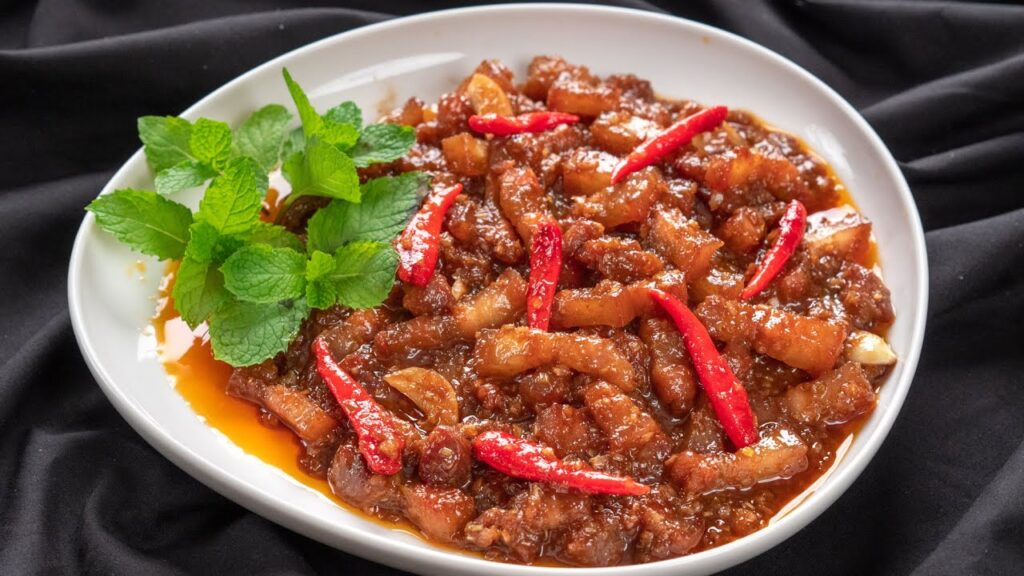
One of the most iconic uses of Mam Ruoc is in Vietnamese Caramelized Pork Belly with Fermented Shrimp Paste (Thit Xao Mam Ruoc). This hearty dish is beloved for its intense flavors, blending the rich umami of Mam Ruoc with the sweetness of caramelized pork. The pork belly’s fat melts during cooking, combining with the savory shrimp paste to create a robust, fragrant dish.
Ingredients
- 500g pork belly, sliced thinly
- 2 tablespoons Mam Ruoc (fermented shrimp paste)
- 1 tablespoon sugar
- 2 cloves garlic, minced
- 2 tablespoons cooking oil
- 1-2 chili peppers (optional, for heat)
- 1 tablespoon fish sauce
- 1 tablespoon water
- Fresh herbs (cilantro, basil) for garnish
Instructions
- Prepare the Pork: In a large pan, heat the cooking oil over medium heat. Add the minced garlic and sauté until fragrant.
- Caramelize the Pork: Add the sliced pork belly and stir until the pork starts to brown and some of the fat renders. Stir in the sugar and continue to cook until the pork is caramelized.
- Add the Sauce: In a small bowl, mix Mam Ruoc with water, fish sauce, and chili peppers (if using). Pour this mixture into the pan with the pork. Stir well to ensure the pork is coated with the shrimp paste.
- Simmer: Let the pork simmer for about 10 minutes, allowing the sauce to reduce and thicken. Taste and adjust the seasoning with more sugar or fish sauce if necessary.
- Serve: Garnish with fresh herbs and serve hot with steamed rice and fresh vegetables.
Mam Ruoc is an essential condiment in many traditional Vietnamese dishes, especially those from the central and southern regions. Its unique flavor profile elevates simple meals, whether it’s used in a soup, as a dip, or to enhance a hearty dish like Thit Xao Mam Ruoc. The sauce’s long fermentation period not only enriches its flavor but also boosts its health benefits, offering a rich source of amino acids and nutrients beneficial for digestion.
The next time you encounter Mam Ruoc, you’ll know that you’re experiencing a deeply traditional, versatile sauce that is integral to Vietnamese food culture. Whether in a rustic home-cooked meal or a carefully crafted dish like caramelized pork belly, Mam Ruoc brings an authentic taste of Vietnam to your table.
Sot Dau Phong (Peanut Dipping Sauce)
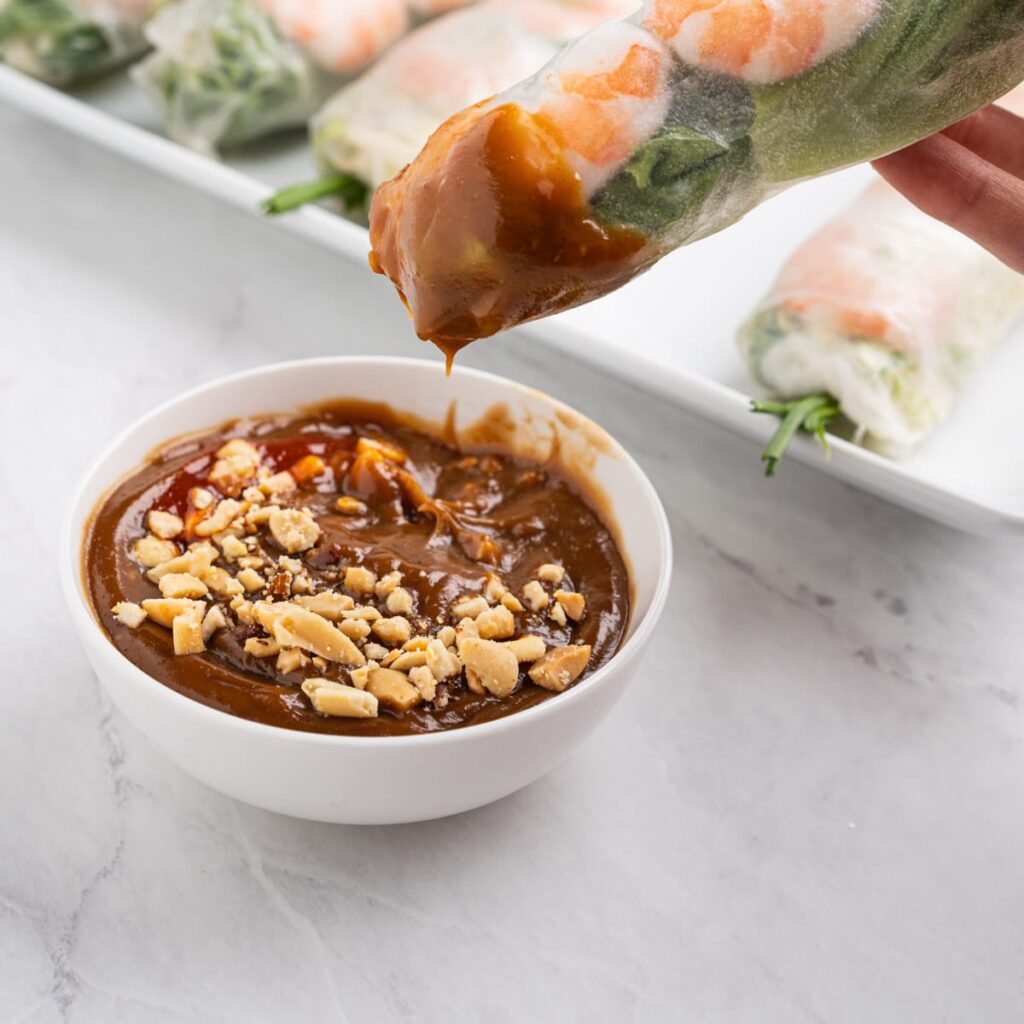
Unlike the other Vietnamese dipping sauces, Sot Dau Phong (Peanut dipping sauce) stands out as its main ingredient is not fish or shrimp, and it does not require months of fermentation. Instead, this sauce relies on the rich, nutty flavor of peanuts, which is balanced by the spiciness of chili and the pungency of garlic. Depending on the dish it’s paired with, additional ingredients like fried pork grind paste or tamarind paste can be added to further enhance the sauce’s depth of flavor.
This versatile sauce is commonly served with dishes like vermicelli with grilled pork (bun thit nuong) and Vietnamese grilled pork sausages (nem nuong), adding a creamy, savory element that complements the freshness of the herbs and the smokiness of the grilled meat.
How to Make Sot Dau Phong (Peanut Dipping Sauce)
Ingredients
- 1/2 cup roasted peanuts
- 2 cloves garlic
- 1-2 red chili peppers
- 1 tablespoon sugar
- 1 tablespoon fish sauce
- 1 teaspoon MSG (optional)
- 2 tablespoons water
- 1 tablespoon tamarind paste (optional)
- 1 teaspoon cornstarch (for thickening, if desired)
- 1 tablespoon lime or kumquat juice
Instructions
- Roast the Peanuts: Start by roasting the peanuts until golden brown. Once they have cooled, rub off their outer shells and set them aside for pounding.
- Prepare the Ingredients: Cut the chili in half and remove the seeds to control the level of spiciness. If you prefer a spicier sauce, you can leave the seeds intact. Peel the garlic cloves.
- Pound the Ingredients: Using a mortar and pestle, pound the peanuts, chili, and garlic together until you get a smooth, well-blended mixture. For a more flavorful sauce, make sure to grind the ingredients finely.
- Add the Seasonings: Mix in the sugar and continue pounding until well combined. If you’re using MSG, add it to balance the flavors. After achieving the desired consistency, pour the mixture into a bowl.
- Final Touches: Add fish sauce, tamarind paste (if using), lime or kumquat juice, and water. Stir everything well to blend the flavors. If you prefer a thicker sauce, dissolve a teaspoon of cornstarch in water, bring it to a boil, and then let it cool before adding it to the sauce.
- Serve and Enjoy: Once the sauce is ready, taste and adjust the seasonings to suit your preference. Pair this rich and creamy peanut dipping sauce with grilled pork, vermicelli, or grilled pork sausages for an authentic Vietnamese dining experience.
What to Eat with Peanut Dipping Sauce
Sot Dau Phong is often used as a dipping sauce for various Vietnamese grilled dishes. Its creamy texture and rich, nutty flavor provide the perfect balance to the smoky, savory meats it accompanies. Some popular pairings include:
- Bun Thit Nuong (Vermicelli with Grilled Pork): The sauce adds a rich, creamy element that complements the fresh herbs, crispy fried shallots, and grilled pork.
- Nem Nuong (Vietnamese Grilled Pork Sausages): Peanut sauce enhances the juicy, flavorful pork sausages with its creamy texture and mildly sweet flavor.
- Banh Xeo (Vietnamese Sizzling Pancake): In some regions, Sot Dau Phong is also served as a dip for Banh Xeo, adding richness to the crispy, savory pancake.
With its versatility and vibrant flavors, Sot Dau Phong is a must-try Vietnamese dipping sauce that brings an additional layer of flavor to many of Vietnam’s most beloved dishes. Its simplicity in preparation and satisfying taste make it a staple in Vietnamese cuisine, elevating both home-cooked meals and street food dishes alike.
Vietnamese Dipping Sauce with Green Chili and Salt

One of the simplest yet most flavorful Vietnamese dipping sauces is the combination of green chili and salt, often paired with seafood dishes. This sauce may look simple, but its bold and vibrant flavors offer a unique complement to fresh seafood, enhancing its taste while also neutralizing any fishy odor.
The ingredients for this sauce—green chili, sugar, salt, condensed milk, lime juice, and young lime leaves—create a well-balanced mix of sweet, spicy, salty, and tangy flavors. The result is an aromatic dipping sauce that enhances the natural taste of seafood, making each bite more flavorful.
How to Make Green Chili and Salt Dipping Sauce
Ingredients
- 5-6 fresh green chilies
- 1/2 teaspoon salt
- 1 tablespoon sugar
- 1 tablespoon condensed milk
- Juice of 1 lime
- 2 young lime leaves (finely chopped)
Instructions
- Prepare the Ingredients: Finely chop the green chilies and lime leaves. You can adjust the amount of chili based on your preferred spice level.
- Combine the Seasonings: In a small bowl, mix the salt and sugar together. Add the chopped chilies and lime leaves, and stir until everything is well combined.
- Add the Liquids: Pour in the condensed milk and freshly squeezed lime juice. Stir until all ingredients are thoroughly mixed and the sauce has a smooth consistency.
- Adjust to Taste: Taste the sauce and adjust the seasoning if needed. If you prefer a sweeter profile, add more condensed milk; for more tang, add extra lime juice.
- Serve and Enjoy: This green chili and salt dipping sauce is best served with grilled or steamed seafood like shrimp, fish, squid, or crab. The sauce’s complex combination of sweet, spicy, and tangy notes pairs beautifully with the freshness of the seafood.
What to Eat with Green Chili and Salt Dipping Sauce
This dipping sauce is particularly popular as a side for seafood, enhancing the natural flavors of shrimp, crab, squid, and fish. Here are some dishes where you can enjoy it:
- Grilled Shrimp or Crab: The sweet and spicy sauce helps elevate the flavors of seafood, making each bite more vibrant and enjoyable.
- Steamed Fish or Squid: The tanginess of the lime juice helps balance out the saltiness, while the condensed milk adds a smooth texture, making it a perfect accompaniment for simply cooked seafood.
- Fried or Boiled Clams and Mussels: This dipping sauce neutralizes any briny taste and adds a delicious spicy kick.
The Vietnamese dipping sauce with green chili and salt is a great example of how simple ingredients can create a complex and flavorful condiment, making it a staple in Vietnamese seafood dining. Its mix of spice, sweetness, and tartness brings out the best in any seafood dish, adding an extra layer of deliciousness to your meal.
Vietnamese Ginger Dipping Sauce

Among the many varieties of Vietnamese dipping sauce, ginger sauce holds a special place for its ability to bring out the best in poultry and seafood dishes. This sauce combines the saltiness of fish sauce, the sweetness of sugar, the acidity of lime juice, and the heat of fresh ginger, creating a balance of flavors that enhances the richness of food. It’s not just delicious but also functional—ginger is known for its digestive benefits, making it an ideal accompaniment to richer dishes.
The beauty of Vietnamese ginger dipping sauce lies in its simplicity and versatility. Whether used with a steaming bowl of congee, a succulent plate of steamed chicken, or a platter of fresh seafood, this sauce brings brightness and zest to your meal. It’s a must-try for anyone looking to experience the depth of flavor that Vietnamese cuisine has to offer. By combining the robust heat of ginger with the savory goodness of fish sauce and a hint of sweetness, this sauce is a culinary staple that perfectly captures the soul of Vietnam’s food culture.
How to make Vietnamese ginger dipping sauce
Ingredients
- 2 oz fresh ginger (about a 2-inch knub)
- 1 large garlic clove, peeled
- 1/4 cup warm water
- 1/4 cup sugar
- 1/4 cup fish sauce
- 2 tablespoons lime juice (about 1 large lime)
- 2 small red chilies, finely chopped
Instructions
- Prepare the Ginger and Garlic: Begin by peeling the ginger and chopping it into small chunks. Place the ginger and garlic clove into a food processor or mortar and pestle and chop finely. The combination of ginger and garlic gives the sauce its distinct bite.
- Mix the Liquid Ingredients: In a separate bowl, add warm water, sugar, fish sauce, and lime juice. Stir this mixture thoroughly until the sugar completely dissolves, forming the base of the sauce. The warm water helps the sugar melt faster, ensuring a smooth texture.
- Combine Everything: Add the finely chopped ginger, garlic, and chilies into the liquid mixture. Stir to ensure everything is well-blended. The chilies will add a slight heat, while the ginger provides warmth and fragrance.
- Let it Rest: For the best flavor, allow the sauce to rest for about 10 minutes. This resting time allows all the ingredients to meld together, creating a balanced, rich flavor that will pair beautifully with your dishes.
What to Eat with Vietnamese Ginger Dipping Sauce
This ginger-infused dipping sauce is a versatile complement to a wide range of traditional Vietnamese dishes. Its brightness enhances the savory richness of poultry and seafood, and its complexity adds depth to simple meals.
- Duck or Chicken Congee: A traditional dish often eaten for breakfast, congee (rice porridge) can be somewhat mild on its own. This ginger dipping sauce adds a sharp, zesty kick that enhances the flavors of the tender duck or chicken served alongside it.
- Steamed or Poached Chicken (Gà Luộc): This dipping sauce is most commonly paired with poached chicken, a popular Vietnamese dish where chicken is boiled and served whole. The ginger’s spiciness perfectly balances the delicate, fatty texture of the chicken.
- Seafood: Whether you’re enjoying steamed or grilled fish, shrimp, or squid, the ginger sauce serves as a great complement. Its acidity from the lime juice cuts through the richness of seafood, while the ginger and garlic provide a deeper, more complex flavor.
- Grilled Duck or Pork: For richer meats like duck or pork, this ginger dipping sauce offers a refreshing contrast, cutting through the fatty flavors with its sharp ginger and tangy lime. The sauce balances the heaviness of these meats, making it a perfect companion.
Vietnamese Tamarind Dipping Sauce

Vietnamese tamarind dipping sauce is one of the most beloved condiments in Southern Vietnam, celebrated for its unique combination of sweet, sour, and savory flavors. Tamarind, known for its tangy profile, pairs beautifully with dishes that are rich, grilled, or fried, cutting through the richness and enhancing the overall flavor. This versatile dipping sauce is a staple for a wide variety of meals, especially those that involve seafood, fried meat, or even fruit.
How to make Vietnamese tamarind dipping sauce
Ingredients
- 3 tablespoons tamarind pulp
- 1 small chili pepper, chopped
- 2 cloves garlic, chopped
- 1/2 teaspoon sugar
- 1 tablespoon fish sauce
Instructions
- Prepare the Tamarind Pulp: Place the tamarind pulp in a heatproof bowl. In a separate pot, bring half a cup of water to a boil, then pour it over the tamarind pulp. Allow the tamarind to soak for about ten minutes, letting the hot water soften the pulp.
- Strain the Tamarind: After soaking, strain the mixture using a fine mesh sieve. Press the tamarind pulp through the mesh to extract the flavorful juice, discarding any leftover fibers or seeds.
- Prepare the Paste: In a mortar and pestle, mash together the chili, garlic, and sugar into a smooth paste. This mixture gives the sauce its signature aromatic kick and a mild sweetness that complements the tamarind’s tang.
- Combine Ingredients: Gradually add the strained tamarind extract to the mortar and pestle mixture, stirring as you go. Finish off by mixing in the fish sauce, which rounds out the flavor with its salty, umami punch.
- Adjust to Taste: Once the sauce is mixed, taste it and adjust the seasoning to your preference. You can add a bit more sugar if you like your sauce sweeter, or more chili if you prefer a spicier kick.
What to Eat with Vietnamese Tamarind Dipping Sauce
This flavorful tamarind sauce is incredibly versatile and pairs well with a variety of Vietnamese dishes, particularly those with bold or rich flavors. Here are some popular dishes that benefit from the sweet and tangy tamarind dipping sauce:
- Grilled Fish: Tamarind dipping sauce is a classic accompaniment for grilled or fried fish. The tangy sweetness of the sauce contrasts beautifully with the rich, crispy skin and tender meat of the fish, creating a refreshing balance in each bite.
- Fried Pork or Chicken: For fried dishes like crispy pork or chicken, the tamarind sauce provides a zesty counterpart. Its tang cuts through the fatty richness of the meat, making each bite feel lighter and more balanced.
- Seafood: This sauce works perfectly with a variety of seafood dishes, from grilled shrimp to squid. The tart tamarind enhances the natural sweetness of the seafood, creating a harmonious flavor combination.
- Fruit Dipping Sauce: In Southern Vietnam, tamarind dipping sauce is often used as a dip for sour fruits like green mango, guava, or pineapple. The sweetness of the sauce complements the tartness of the fruit, making for a delicious and refreshing snack.
- Spring Rolls: Whether you’re enjoying fried spring rolls (cha gio) or fresh ones (goi cuon), tamarind dipping sauce adds an extra layer of flavor. Its combination of sweet, sour, and savory notes pairs perfectly with the freshness and crunch of the rolls.
Vietnamese tamarind dipping sauce adds a vibrant tang to many dishes, elevating the flavors and making them more dynamic. Whether paired with seafood, fried meat, or fresh fruits, this sauce is a must-try for anyone exploring the full range of Vietnamese cuisine. Its balance of sweetness and sourness makes it an essential condiment on the Vietnamese table.
Are There Any Vegetarian or Vegan Vietnamese Dipping Sauces?
Absolutely! In addition to the classic recipes for Vietnamese dipping sauce, Vietnamese cuisine also offers vegetarian and vegan-friendly alternatives. One popular vegetarian dipping sauce is Nuoc Cham Chay, which uses soy sauce as its base instead of fish sauce. This sauce has a balanced blend of flavors—salty, sour, sweet, and a touch of spice—making it the perfect accompaniment to various plant-based dishes like salad noodles, spring rolls, and dumplings.
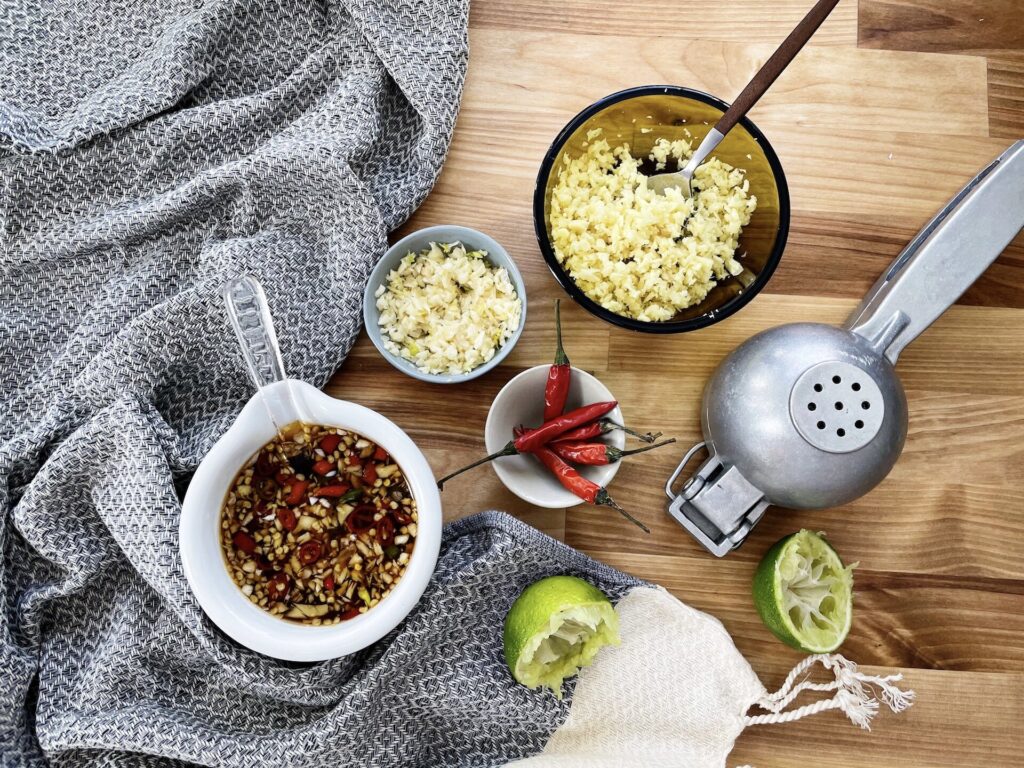
How to Make Nuoc Cham Chay (Vegetarian Dipping Sauce):
Ingredients
- 2 tablespoons soy sauce
- 1/4 cup hot water
- 2 cloves garlic, finely chopped
- 1 teaspoon green chili sauce (optional for extra heat)
- 1 tablespoon lemon juice
- 1 teaspoon sugar
Instructions
- Dissolve the Sugar: Begin by mixing the sugar with hot water, stirring until the sugar completely dissolves.
- Combine Ingredients: In a separate bowl, mix together the soy sauce, lemon juice, minced garlic, and chili sauce.
- Blend the Mixtures: Slowly add the sugar water into the soy sauce mixture, stirring well to combine all the flavors.
- Taste and Adjust: Adjust the soy sauce or chili sauce according to your preference for saltiness or spiciness.
- Serve: Serve the Nuoc Cham Chay dipping sauce alongside dishes like Banh It Tran dumplings or fresh spring rolls.
Using Vegetarian Fish Sauce in Vietnamese Dipping Sauces
Another option for making your dipping sauce vegetarian or vegan is by substituting regular fish sauce with vegetarian fish sauce. This sauce, often made from plant-based ingredients like pineapple, coconut milk, mushrooms, or cashews, mimics the umami and salty notes of traditional fish sauce while remaining cruelty-free. Vegetarian fish sauce is widely available in Vietnam, but for those who like to experiment, homemade versions can offer a flavorful and health-conscious alternative.
Whether you’re dipping fresh rolls or using it as a marinade, vegetarian Vietnamese dipping sauces provide a delicious way to enjoy the bold and balanced flavors of Vietnamese cuisine while staying true to plant-based diets.
Let’s Wrap It Up
Now you understand why a bowl of dipping sauce is always the centerpiece of every Vietnamese meal. The significance of Vietnamese dipping sauce in elevating the flavors of simple dishes is undeniable. It’s not just a side accompaniment—it’s the very soul of Vietnamese cuisine. If you’re on a journey to explore Vietnamese food, familiarizing yourself with these five popular dipping sauces is an absolute must.
Thank you for taking the time to learn about the essential sauces that shape Vietnamese cuisine! Whether you’re cooking at home or enjoying a meal in Vietnam, these dipping sauces are key to unlocking the authentic flavors of the country.
Other articles for exploring Ho Chi Minh City
- 25 unusual things to do in Ho Chi Minh
- 12 must-do tours in Ho Chi Minh
- 26 highlights in Ho Chi Minh’s Chinatown
- 20 Things To Do In Ho Chi Minh City At Night
- 25 Things to Do with Kids in Ho Chi Minh City
Ho Chi Minh City Cycling Tour In Ho Chi Minh City (Saigon) – Vietnam

At Jackfruit Adventure, we organize Ho Chi Minh City Cycling Tour and Team Building Ho Chi Minh. With a deep knowledge of Saigon city and local connections, we believe we can give you an awesome bonding time together. Contact us today if you have any requests or questions to prepare a trip for your team to bond in Ho Chi Minh – Vietnam.




